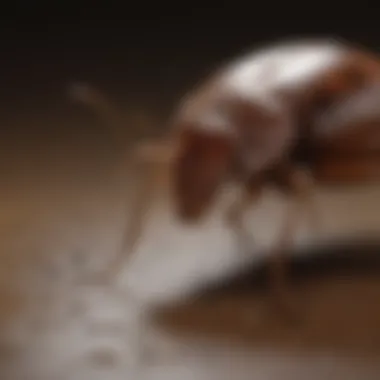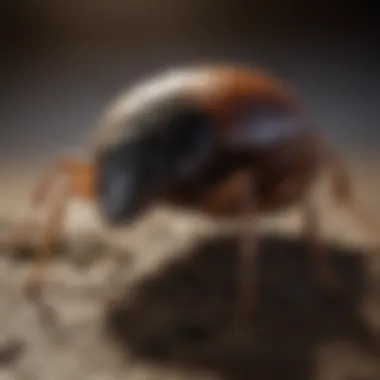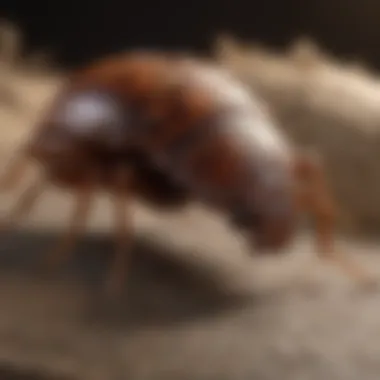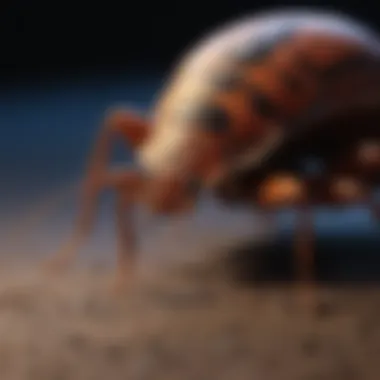Unveiling the Power of Black Lights in Bed Bug Detection


Black lights have emerged as a fascinating tool in identifying the pesky presence of bed bugs, bringing a fresh perspective to pest inspection methods. The innovative approach of utilizing black lights entices both novices and experts alike with its blend of science and practicality. In this detailed exploration, we will unravel the scientific principles behind this method, evaluate its efficiency, and provide essential tips for conducting thorough inspections.
The Science Behind Black Light Detection
In the realm of pest detection, black lights serve as a unique ally, revealing hidden traces of bed bugs that elude the naked eye. This method capitalizes on the insects' natural fluorescence under ultraviolet light, making their presence unmistakably visible. Understanding the underlying biology of bed bugs and their distinctive reaction to black light is crucial in mastering this technique.
Under the stark illumination of a black light, bed bugs illuminate a fluorescent blue hue, contrasting sharply against the dark backdrop. This fluorescence stems from certain substances present in the bugs' exoskeleton, a feature that is pivotal for accurate identification. Discerning this telltale glow amidst the environmental shadows requires keen observation and a trained eye.
Effectiveness of Black Light Inspection
The effectiveness of black light inspection in detecting bed bugs has garnered attention for its reliability and precision. By leveraging this non-invasive technique, inspectors can swiftly scan a room, pinpointing infestations with remarkable accuracy. Unlike traditional methods that rely on physical sightings or laborious examinations, black lights offer a swift and comprehensive solution for identifying bed bug hotspots.
Moreover, the portability and ease of use of black light devices enhance their practicality, enabling inspectors to navigate diverse settings effortlessly. From hotel rooms to residential spaces, the versatility of black lights makes them indispensable tools in the battle against bed bugs. When integrated with thorough visual inspections, black lights elevate efficiency and ensure thoroughness in pest management protocols.
Practical Tips for Effective Inspections
To maximize the efficacy of black light inspections, employing strategic techniques and following best practices is essential. Begin by conducting a systematic sweep of the area, scanning surfaces methodically while paying close attention to common hiding spots. Focus on areas near bedding, furniture seams, and wall crevices, as bed bugs tend to congregate in these sheltered locations.
Maintaining a darkened environment during inspections is paramount, as it enhances the visibility of fluorescent markers emitted by bed bugs. Shield ambient light sources and utilize the black light in dimly lit conditions to accentuate the fluorescence for optimal detection. Additionally, regular calibration and maintenance of the black light device ensure consistent performance and accurate readings.
In summary, the use of black lights for detecting bed bugs signifies a significant advancement in pest management strategies. With a discerning eye, a thorough understanding of the science behind this method, and adherence to best practices, inspectors can wield black lights effectively in identifying and mitigating bed bug infestations.
Preamble
In this riveting exploration, we delve into the fascinating realm of using black lights as a tool for uncovering the presence of elusive bed bugs. This methodological approach not only revolutionizes pest control but also offers a non-invasive and efficient means of detection. By shedding light on the efficacy and nuances of black light inspection, we aim to equip our readers with essential knowledge for safeguarding their living spaces against this nocturnal nuisance.
Understanding Bed Bugs
Physical Characteristics
Exploring the intricate world of bed bugs begins with a deep dive into their physical attributes. The minute size of these pests, ranging from a mere 1 to 7 millimeters, coupled with their flat, oval-shaped bodies, enables them to adeptly conceal themselves within crevices and upholstery. Their reddish-brown hue serves as a distinctive characteristic, making them adept at blending into bedding and furniture. While their lack of wings may seem limiting, bed bugs compensate by swiftly maneuvering across various surfaces, aided by their six spindly legs.


Behavioral Patterns
The behavioral patterns exhibited by bed bugs significantly influence their detection and eradication. These adept hitchhikers display a remarkable proclivity for nocturnal activity, seeking out human hosts during the cover of darkness to feed on their blood. Their elusive nature, combined with their ability to reproduce rapidly, poses a formidable challenge for eradication efforts. Understanding their attraction to warmth and carbon dioxide emissions is crucial for honing in on potential infestation sites.
Common Habitats
Bed bugs showcase a remarkable adaptability to a diverse range of habitats, making them prevalent in myriad settings. From residential homes and hotels to public transportation and healthcare facilities, these resilient pests can thrive in the most unsuspecting locations. Their affinity for cozy nooks such as mattress seams, headboards, and electrical outlets underscores the importance of thorough inspection when suspecting an infestation. By acquainting ourselves with their favored dwellings, we arm ourselves with the knowledge needed to combat their insidious presence effectively.
Importance of Detection
Health Risks
The health risks associated with bed bug infestations extend beyond physical discomfort, encompassing mental stress and allergic reactions. Prolonged exposure to bed bug bites can trigger anxiety and sleep disturbances, dramatically impacting one's quality of life. Moreover, individuals with heightened sensitivities may experience severe skin irritation and inflammation, requiring medical intervention. By advocating for proactive detection measures, we aim to mitigate these health hazards and promote a hygienic living environment.
Prevention Strategies
Prevention lies at the heart of combating bed bug infestations, emphasizing the significance of early detection and intervention. Implementing vigilant hygiene practices, such as regular vacuuming and laundering bedding at high temperatures, serves as a foundational strategy for keeping bed bugs at bay. Additionally, sealing cracks and crevices, decluttering living spaces, and investing in protective mattress encasements all contribute to creating a hostile environment for these resilient pests. Through a proactive approach to prevention, individuals can safeguard their homes and well-being against the pervasive threat of bed bugs.
Science Behind Using Black Lights
In delving into the realm of bed bug detection, the Science Behind Using Black Lights emerges as a critical focal point. This facet of the article illuminates the intricate relationship between ultraviolet (UV) light and bed bugs, shedding light on how these pests react when exposed to UV rays. By examining their response and visible effects under black lights, it becomes evident why this method is gaining prominence. The effectiveness of black lights lies in their ability to unveil hidden clusters of bed bugs that might otherwise elude visual detection, elevating the inspection process to a more meticulous level. Science Behind Using Black Lights offers a scientific foundation for understanding how these pests interact with UV light, offering invaluable insights into improving detection strategies.
UV Light and Bed Bugs
Response to UV light:
When discussing the Response to UV Light, the key consideration revolves around how bed bugs react when exposed to ultraviolet light. Their unique sensitivity to certain wavelengths makes them fluoresce, making them visible under black lights. This characteristic response serves as a distinctive feature for detection, allowing for swift identification of infested areas. However, this method is not devoid of limitations, as some bed bug strains may exhibit reduced sensitivity to UV light, compromising the accuracy of detection in certain cases.
Visible Effects:
The Visible Effects of UV light exposure on bed bugs unveil a myriad of details essential for effective detection. By observing the visible fluorescence of these pests under black lights, inspectors can pinpoint infestation hotspots with precision. This inherent visual cue enhances the overall accuracy of inspections, enabling thorough eradication measures to be implemented promptly. Despite its advantages in enhancing detection efficacy, the reliance on visible effects alone may pose challenges in identifying dormant or less active bed bug populations.


Effectiveness of Black Lights
Limitations:
Exploring the Limitations of black lights in bed bug detection reveals potential challenges that practitioners may encounter. While black lights offer a non-invasive and efficient method for identifying infestations, their efficacy may be hindered by certain factors. For instance, variations in bed bug species' fluorescence intensity can affect the reliability of detection outcomes, necessitating complementary inspection methods for comprehensive results.
Accuracy:
The Accuracy of black lights serves as a testament to their utility in detecting bed bugs. By providing real-time feedback through fluorescence visualization, black lights enable inspectors to make immediate decisions regarding treatment strategies. The high precision offered by black lights enhances the efficiency of inspections, minimizing the margin for error and ensuring thorough coverage of potential infestation sites.
Methods for Inspection
In the realm of pest control and bed bug detection, the section on Methods for Inspection assumes paramount importance. It serves as the linchpin of the entire process, ensuring thorough and effective identification of these elusive creatures. By focusing on black light utilization, inspectors can leverage a non-invasive yet potent tool that reveals the hidden presence of bed bugs. This method not only assists in timely detection but also aids in formulating targeted treatment strategies, enhancing efficacy while minimizing resource expenditure and environmental impact. Through meticulous examination and data interpretation, the application of black lights empowers professionals and homeowners alike to proactively combat the potential ramifications of bed bug infestations. Strategic planning and methodical execution underline the significance of incorporating precise inspection techniques, cementing the ways in which black lights revolutionize the detection process.
Using a Black Light
Procedure
The procedure related to utilizing a black light in bed bug detection is a pivotal aspect of this investigative process. It involves illuminating suspected areas with a black light to identify fluorescent signals indicative of bed bug presence. This method warrants attention due to its non-invasiveness and efficiency in highlighting otherwise imperceptible signs of infestation. One key characteristic of this procedure is its ability to pinpoint even the smallest traces of bed bug activity, contributing significantly to the overall inspection process's thoroughness and accuracy. Despite its efficacy, potential drawbacks lie in the dependence on darkness for optimal results, along with the need for trained eyes to decipher the findings effectively. The nuanced approach of the black light procedure enriches the inspection experience, offering a level of detail that traditional methods often overlook.
Best Practices
When delving into the realm of using black lights for detecting bed bugs, adhering to best practices becomes paramount for optimal outcomes. These practices encompass a meticulous approach to inspection, ensuring comprehensive coverage of all potential harborage areas. Emphasizing systematic scanning and documentation enhances the reliability and repeatability of inspection results, facilitating informed decision-making regarding treatment strategies. The unique feature of best practices lies in their ability to streamline the detection process, encouraging a standardized methodology that maximizes efficiency and accuracy. While advantages include enhanced speed and precision in identification, adherence to best practices demands a keen eye for detail and a commitment to thoroughness that culminates in superior bed bug management outcomes. Striking a balance between technique and tenacity, best practices underscore the significance of methodical inspection protocols in the context of black light utilization.
Combining Methods
Visual Inspection
Within the landscape of bed bug detection methodologies, visual inspection stands out as a cornerstone element with inherent value. By visually scanning targeted areas for signs of bed bug activity, inspectors can gather crucial visual cues that complement the potential findings under black light scrutiny. A key characteristic of visual inspection lies in its ability to provide immediate visual feedback, aiding in quick decision-making during the inspection process. This method's popularity stems from its simplicity and accessibility, offering a foundation for comprehensive examination that augments the insights gained from black light assessments. The unique feature of visual inspection lies in its capacity to serve as a preliminary screening tool, guiding subsequent inspection steps with targeted focus and precision. Furthermore, by integrating visual inspection with black light utilization, inspectors can harness a multifaceted approach that maximizes detection efficacy while minimizing overlooked areas of concern.
Bedding Examination


Complementing the black light methodology, bedding examination assumes a crucial role in the holistic approach to bed bug detection. By scrutinizing bedding materials for signs of infestation, inspectors can uncover vital clues that aid in confirming and delineating the extent of bed bug presence. The key characteristic of bedding examination lies in its ability to reveal harborage sites often favored by bed bugs, providing valuable insights into infestation patterns and severity. This choice for inspection bolsters the overall assessment process, offering a targeted evaluation of high-risk areas within the vicinity of potential bed bug activity. The unique feature of bedding examination is its practical applicability in diverse settings, from residential homes to commercial establishments, enhancing the adaptability and versatility of inspection protocols. While advantageous in its specificity and targeted approach, bedding examination necessitates meticulous attention to detail and comprehensive coverage to extract maximal diagnostic value, reinforcing its position as a cornerstone component in the multifaceted approach to bed bug detection.
Tips for Effective Detection
When discussing the critical aspect of effective detection in the context of bed bug identification, one cannot underestimate its significance. In the quest to combat these elusive pests, being equipped with the knowledge of key detection strategies is paramount. Effective detection techniques serve as the cornerstone of successful bed bug management, enabling homeowners and pest control professionals to pinpoint infestations promptly and implement appropriate control measures. By honing in on specific signs and utilizing advanced detection tools like black lights, individuals can elevate their pest control efforts to a new level of precision.
Identifying Signs
Fecal Stains
In the landscape of bed bug detection, fecal stains occupy a prominent position due to their undeniable role in signaling infestations. These dark, rust-colored markings are a telltale sign of bed bug activity and can be found on various surfaces such as bedding, mattresses, and furniture. Fecal stains are created by the digestion process of bed bugs, leaving behind distinct marks that distinguish their presence. While unsightly, these stains serve as valuable indicators for both preliminary inspections and ongoing monitoring routines.
Blood Smears
Equally crucial in the realm of bed bug detection are blood smears, another visual cue of these nocturnal parasites' feeding habits. Blood smears result from accidental crushing of bed bugs during or after a blood meal, leading to reddish-brown streaks on surfaces. Unlike fecal stains, blood smears directly reflect recent feeding activity, offering real-time insights into the proximity and level of infestation. However, it is essential to note that variability in blood smear appearance can occur based on factors like bed bug developmental stage and feeding frequency, necessitating careful examination for accurate interpretation.
Areas of Focus
Hotspots
When orchestrating a comprehensive bed bug inspection, attention to hotspots emerges as a crucial strategy for targeted detection. Hotspots refer to specific areas within living spaces where bed bugs are more likely to congregate or establish harborage sites. Common hotspots include near beds, along baseboards, behind wall hangings, and within cluttered spaces. By concentrating efforts on these high-risk zones, individuals can maximize detection efficiency and proactively address potential infestation sources. In essence, identifying and scrutinizing hotspots form a key pillar of successful bed bug management practices.
Hidden Spots
Contrasting with hotspots, hidden spots present a distinct challenge in the battle against bed bugs due to their elusive nature. These concealed locations serve as refuge for bed bugs during daylight hours, offering protective cover from prying eyes and intervention measures. Examples of hidden spots encompass wall voids, electrical outlets, seams of furniture, and cracks in flooring. Infiltrating these covert hideouts demands meticulous inspection and strategic use of detection tools like black lights to unveil the presence of bed bugs where they least expect. Successfully navigating hidden spots requires persistence, attention to detail, and a comprehensive understanding of bed bug behavior patterns.
Culmination
Black lights have emerged as a fascinating tool in the realm of bed bug detection. Their utilization brings about a paradigm shift in the way we approach identifying these elusive pests within our living spaces. By shedding light on the significance of black lights, this article aims to underscore key aspects that highlight the prowess of this innovative technique.
Final Thoughts
Summary of Findings
In dissecting the intricacies of the findings, it becomes evident that black lights offer a unique perspective in uncovering the presence of bed bugs. Their ability to reveal subtle traces of fecal stains and blood smears amplifies the efficiency of detection, thereby enhancing the overall inspection process. The distinct advantage of black lights lies in their precision, enabling inspectors to pinpoint hotspots and hidden spots with unmatched accuracy.
Recommendations
When delving into the recommendations put forth, it becomes apparent that integrating black lights into the inspection routine is paramount. The comprehensive nature of their coverage ensures a meticulous examination of potential infestation areas. Despite their efficacy, it is vital to supplement black light inspections with other detection methods to offset any limitations and ensure a thorough evaluation of the premises.







